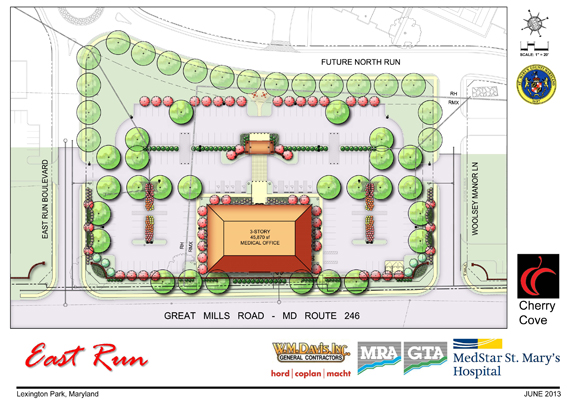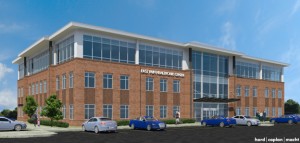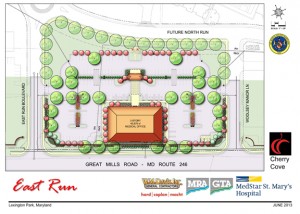Health Enterprise Zone Elements Coming Together

By Sheila Gibbons Hiebert
Maryland’s newly announced health enterprise zones are getting a lot of attention – a whole lot.
The state’s designation of five health enterprise zones, of which Lexington Park is one, is an effort to deliver health services and infrastructure to underserved communities. The economic enterprise zone model has been used by at least 42 states since the 1950s, typically with the goals of driving investment and jobs to areas that have been languishing or falling short of their potential. Maryland’s health enterprise zone program, announced in January, is a new take on that model, adapted to attract health care professionals, especially doctors, to work in these communities, and developers to build them the facilities they need.
Jointly administered by the Community Health Resources Commission and Maryland Department of Health and Mental Hygiene, the HEZ Initiative is a four-year pilot program with a budget of $3.4 million per year. Success will depend on the degree to which the HEZs can reduce health disparities among racial and ethnic minority populations and among geographic areas, improve health care access and health outcomes in underserved communities, and reduce health care costs and hospital admissions and re-admissions.
Policy makers and health care advocates here and nationwide are watching Maryland’s moves with interest. Writing in Kaiser Health News, Dr. E. Albert Reece, vice president for medical affairs at the University of Maryland, praised the HEZ initiative for seeking “to empower and engage individuals and communities where the greatest disparities exist.” Stuart Butler, director of the Center for Policy Innovation at The Heritage Foundation, urged the state to “pare back regulations” and cut through “land-use red tape” to facilitate faster development of facilities in HEZ communities.
Medstar St. Mary’s Hospital is providing leadership to develop Lexington Park’s HEZ. With its consortium partners, the hospital will target asthma, diabetes, high blood pressure, chronic obstructive pulmonary disease, congestive heart failure, and behavioral health conditions.
Toppling barriers to quality health care is a stated goal of the HEZ. “Access to health care is one of the disparities we are addressing,” says Joan Gelrud, vice president, MedStar St. Mary’s. “There are populations in our county that have great access and populations that have zero.” The key will be the integrated health services approach, in which clients will be cross-screened for mental and physical health conditions.
“Integrated is not the same as co-located,” Ms. Gelrud says. “People come to get care for a stomach ache or a sore throat, but really may also have mental health illnesses. That gets missed a lot. So our integrated approach says if they go for a physical complaint, they’ll also be screened for mental health; if they go in with a mental health issue, there also will be a screening for primary medical needs.”
What’s been the greatest challenge thus far to launching the HEZ?
“The most pressing issue, and it was raised by the Community Health Resources Commission when they interviewed us about the grant award, had to do with being able to come through with recruiting the number of health care providers we said we would,” Ms. Gelrud says. “The toughest recruitment out of this group is psychiatry. The fact that we got a fulltime psychiatrist boarded in adult and pediatric psychiatry [L’Tanya Haith, M.D.] was reassuring to us, as was Walden Behavioral Health’s recruitment of two social workers to work with our psychiatrist. It’s a tall order to bring in the number of practitioners we’ve set out to. Right now we’re focusing on recruiting primary care providers.”
The HEZ grant funding also makes possible additional tuition reimbursement dollars and state income tax abatements that are inducements for physicians to relocate to Southern Maryland and practice in the HEZ, Ms. Gelrud says.
The Health Connections van is providing the integrated services model now on a limited basis, parking in Millison Plaza adjacent to Walden. When a new medical building to be built by Cherry Cove Development opens on Great Mills Road in 2014, the integrated health center will be a tenant there. Eventually a 10-person bus will run on a regular loop centered on the Great Mills Road corridor, with stops in residential areas, pharmacies, gyms, parks, grocery stores and the health center.
“Right now we’re interviewing for an HEZ coordinator and clinical coordinator who will follow patients from the office and physician practices into the hospital and back out again to coordinate care,” Ms. Gelrud says. “And we will be hiring six part-time community health workers who will have been through very specific training and will be in churches, barber shops and other gathering places to be able to meet with and visit patients and provide evidence-based health education to encourage health literacy and using Health Connections to the fullest extent available.
“Once we have the Get Connected to Health program in a new van or bricks and mortar, the old van is going to be rehabbed into two dental rooms,” Ms. Gelrud says. “Part of our grant funding is incentives for dentists and hygienists to provide oral care for people who don’t have access to it. Medical assistance doesn’t have much of a dental benefit, and many dentists don’t accept medical assistance so even folks with medical insurance don’t always have dental care – a big concern because the oral care connection to heart health can’t be overlooked. The inspiration for this came from Dr. Garner Morgan, who helped us sponsor the first Mission of Mercy [a free dental clean held in June 2012]. Once hundreds of them received dental care, the part that struck us was there wasn’t a place to hand these people off to. This is our attempt to put in place another reduction in health are disparities.”
The planned 45,870-square-foot medical building is now going through Planning Commission review. Brian Norris, Cherry Cove CEO, says the project will be very green – “LEED-certified Silver, at a minimum” – with dedicated parking for low-emission vehicles and two charging stations for electric vehicles.
“We also did a great deal of research and planning to make sure of its accessibility so people won’t have to walk over tops of curb islands to get from one place in the parking lot to another,” Mr. Norris says.
He anticipates breaking ground in the fall and opening a year later. The building will house medical and dental offices and Cherry Cove’s own headquarters.























